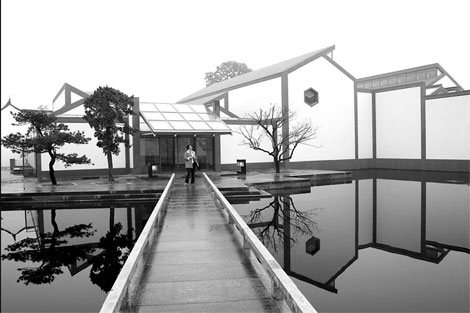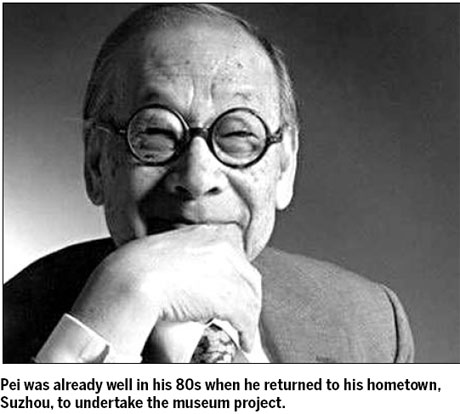Poetry set in stone
|
 The Suzhou Museum is a graceful and lyrical essay illustrating Chinese-American architect I.M. Pei's ideas. China Photo Press |
Renowned architect I.M. Pei may have made world headlines with his controversial glass pyramid at the Louvre, but that is not the project that means the most to him. Chen Weihua reports
Chinese-American architect I.M. Pei has left the world many landmarks, but the one that means the most to him is probably the Suzhou Museum in his ancestral hometown of Suzhou, Jiangsu province.
"The project is a biography for myself," Pei says in the trailer of the documentary I.M. Pei: Building China Modern, which airs nationwide in the United States from Wednesday night.
The documentary is part of the 24th season of the American Masters series on the US Public Broadcasting Service (PBS). It traces Pei's involvement with the Suzhou project over a period of eight years.
Pei was born in China in 1917, but left in1935 to study at the University of Pennsylvania, MIT, and the Harvard Graduate School of Design.
He is perhaps best known for the glass pyramid at the Louvre in Paris, the East Wing of the National Gallery in Washington DC, and the Bank of China tower in Hong Kong, In 1983 he won the prestigious Pritzker Prize, considered the Nobel Prize of architecture.
Now 92, Pei and his wife Eileen were present at the premiere of the documentary at the Paley Center in New York, a few days ago,
Pei was already well into his 80s when he returned to Suzhou to undertake his most personal project to date. He was asked to build a modern museum in the city's oldest neighborhood.
"At this age I don't have to do more. I have already proved myself. But this thing (the Suzhou Museum) I feel I have to do," Pei says in the documentary.
The master of modern architecture found the project challenging because he had lived in the US for 70 years and felt like a foreigner in Suzhou. He felt he had "to find the spirit of the city and the history of the place", Pei says.
The documentary starts with scenes of the glass pyramid of the Louvre and Pei recalling the criticism he received from the French public. "I could not walk in Paris' streets because people would ask, 'what are you doing to our Louvre?'" he says.
However, Pei felt the Louvre needed a change; he felt the same way about Suzhou.
"It's a very poetic place. Water is everywhere. The most important thing is that you have to look at it as a city of 2,500 years built on wood, tiles and bricks. It is a city of life.
"A museum has to reflect this tradition; at the same time it has to think of change. Suzhou cannot remain like this forever. It has to renew itself, to become modern," he says.
Eventually, Pei was able to convince local government officials not to use a tile roof, which Pei thought was too heavy for the structure.
Pei retained Suzhou's traditional palette of white and gray, yet, when people walk into the building, they feel they are seeing something new.
Pei is not immune to criticism in China.
Lu Zhou, vice-dean of the School of Architecture at Tsinghua University, was a sharp critic of Pei's designs, including the Suzhou project and the Louvre.
According to Lu, Pei's design has destroyed the environment surrounding the Humble Administrator's Garden, one of UNESCO's heritage sites located next to the Suzhou Museum.
As with some of his earlier projects that received harsh criticism, Pei persisted. "It's a matter of principle to me how to go to the next century," he says.
Pei's colleagues were aware of his strong involvement with the Suzhou project. "We see him a lot more frequently. This project really touches his heart," says Richard Lee of Pei Partnership Architects.
Pei has been very critical of some buildings in Chinese cities. "China's architecture doesn't have a sense of direction," he says. In his work, he says he intends to show people the combination of a modernist and a traditionalist.
Architectural historian Charles Jencks and John Cobb, a philosopher at the Claremont Graduate School, narrate the documentary. Both have heaped praise on Pei.
"The Suzhou Museum is in many ways a graceful and lyrical essay of his ideas, a combination of his dreams he had at Harvard," says Jencks, referring to Pei's design thesis about a new museum in Shanghai while he was a student at Harvard.
Eugene Shirley, executive producer of the documentary, says the project goes back 10 years to when a company he co-owned wanted to do a film or series on China's modern development.
"The issue we were interested in exploring was the tension between modernity and traditional Chinese culture," he says in a panel discussion after the premiere at the Paley Center.
With the help of Pei's eldest son, Shirley and his team joined I.M. Pei on his first site visit to Suzhou in the spring of 2002. From there, "we follow the story as it unfolded over the next eight years", he says.
Shirley, who made 17 trips to China for the documentary, was surprised at first by Pei's popularity in China. "I remember the first time we were in Suzhou in 2002. Following Mr Pei was like following an American rock star. There was the police escort, tons of photographers and journalists and big crowds," Shirley recalls.
|
 |


















